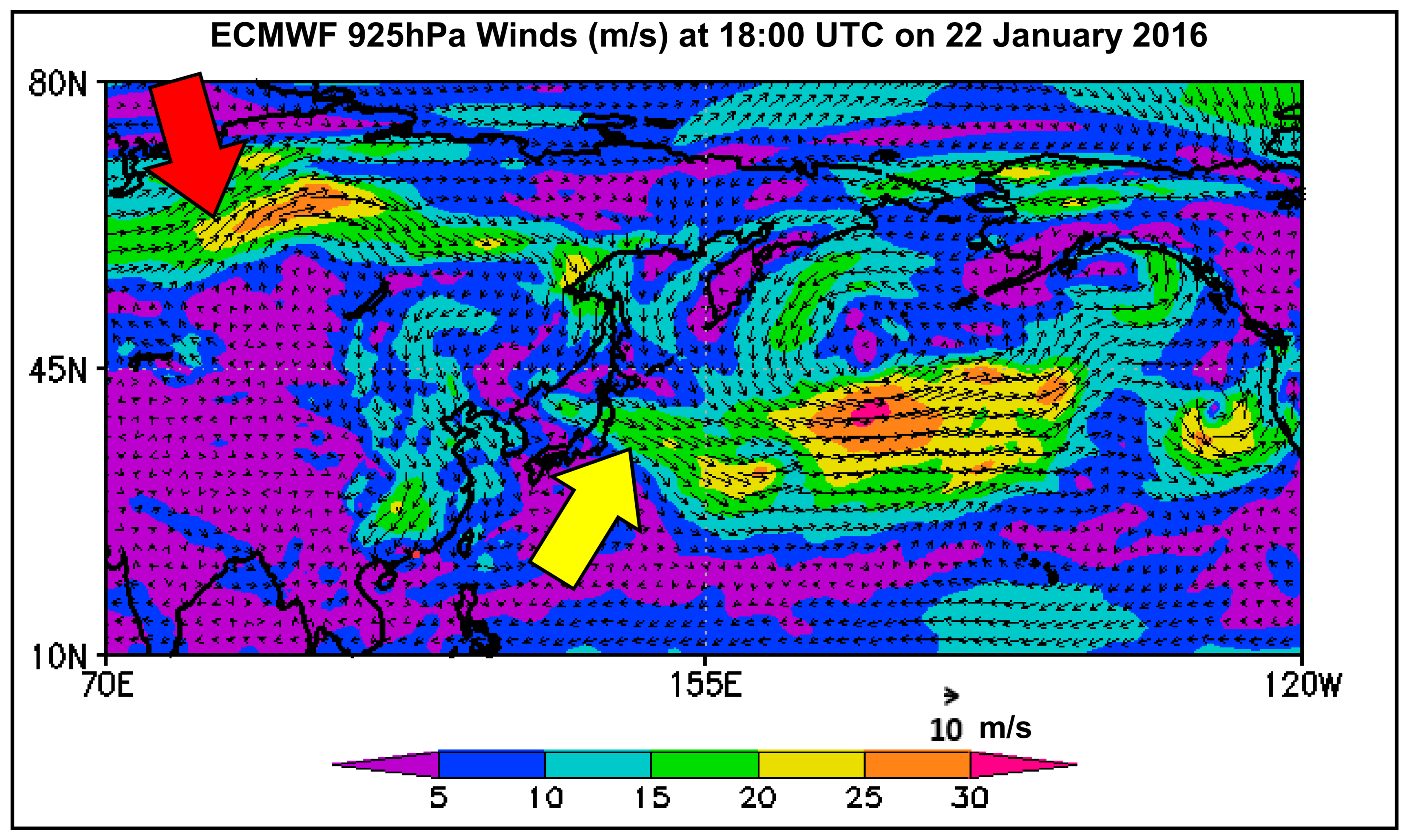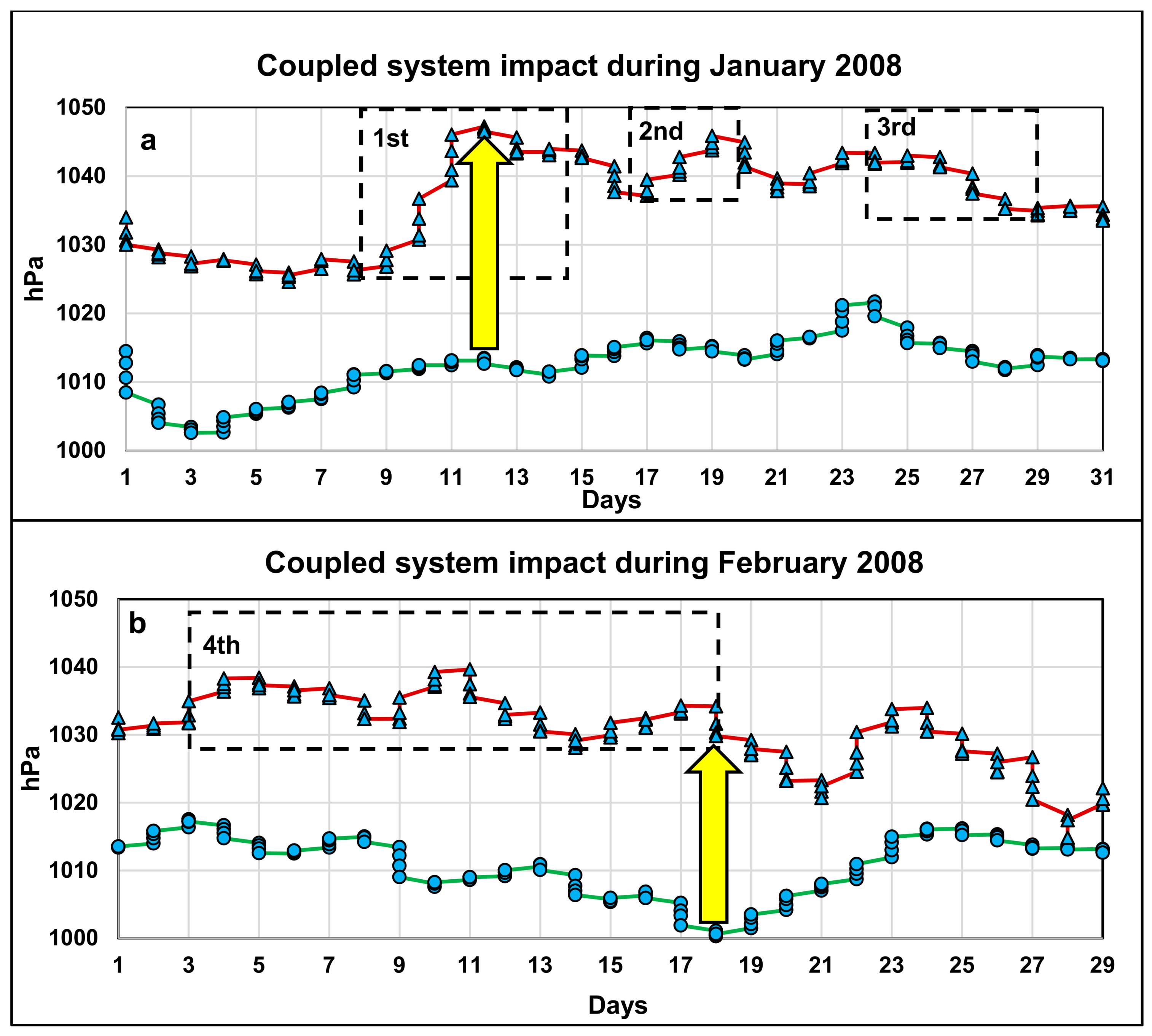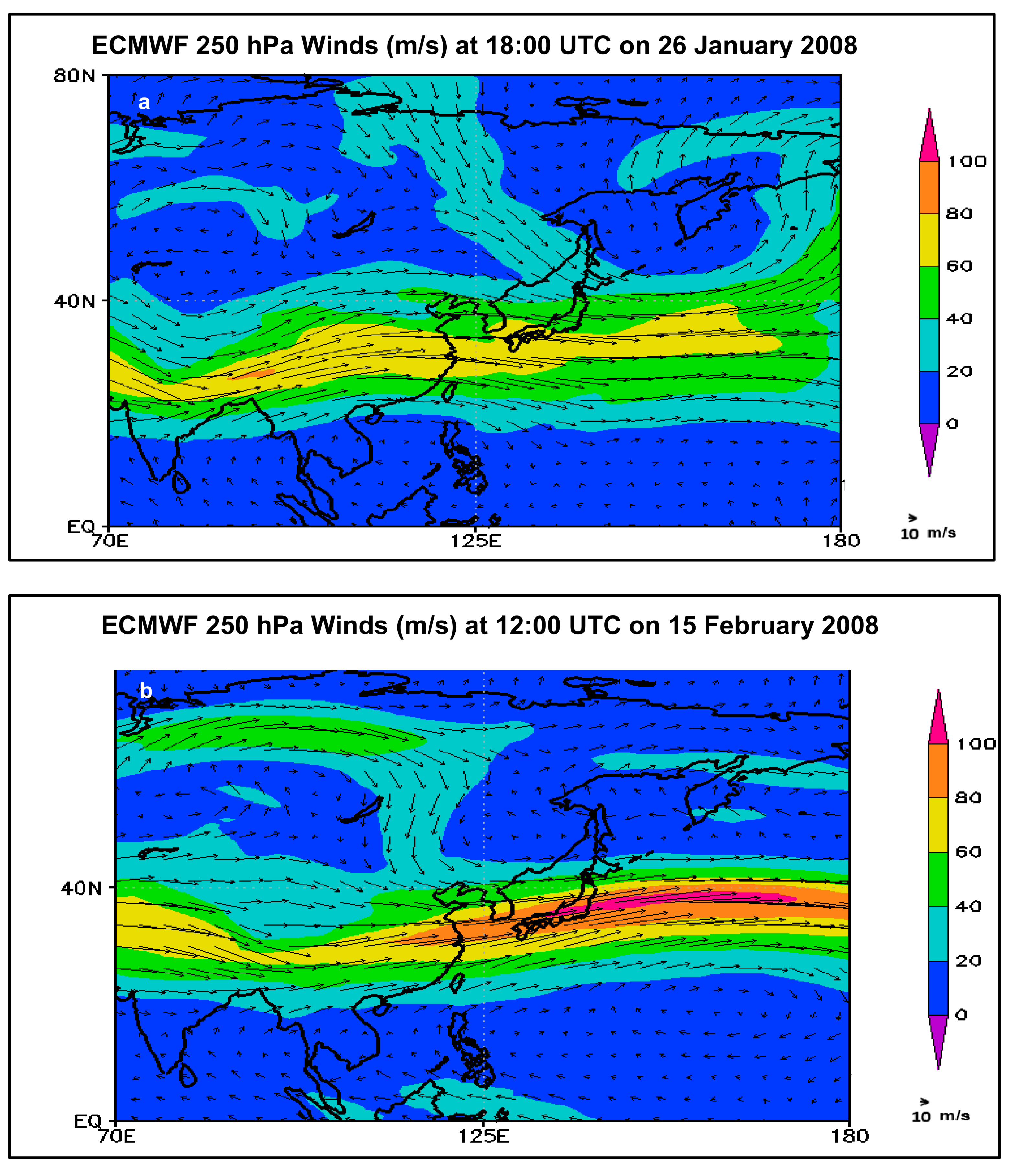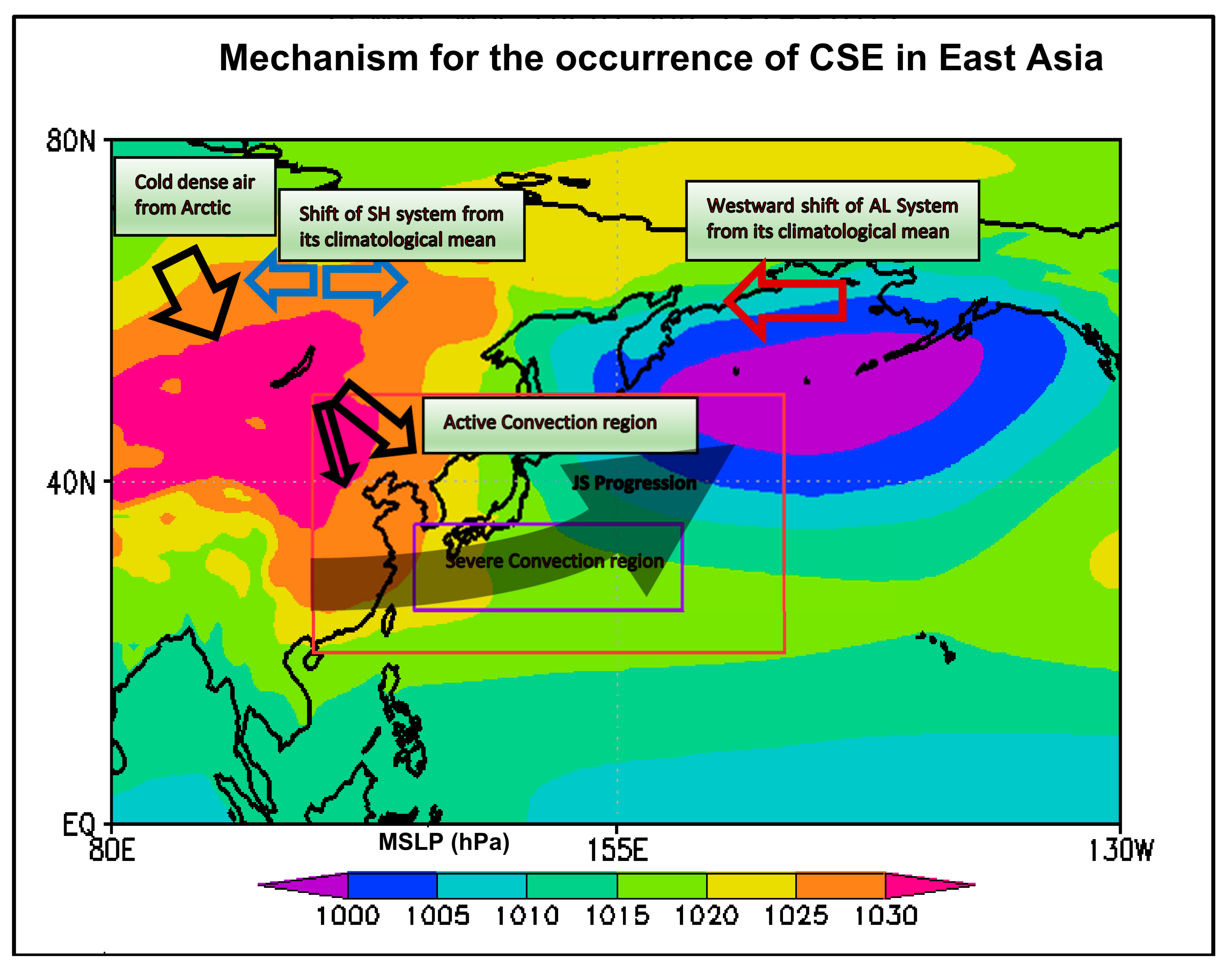Relationship between East Asian Cold Surges and Synoptic Patterns: A New Coupling Framework
Abstract
:1. Introduction
- (1)
- Influence from a single semi-permanent system (anticyclonic high pressure system over Siberia)
- (2)
- Coupled semi-permanent systems (anticyclonic high pressure system over Siberia and cyclonic low pressure system over Aleutian Island)
- (3)
- Influence from the upper troposphere via simultaneous forcing by upper level easterly winds and formation of low pressure systems near the coast of Japan.
2. Possible Mechanism on the Outbreak of CSE
2.1. Influence from a Single System
2.2. Influence from a Coupled System
3. A New Coupling Framework
4. Summary
Supplementary Materials
Author Contributions
Funding
Acknowledgments
Conflicts of Interest
References
- Chen, T.C.; Yen, M.C.; Huang, W.R.; Gallus, W.A. An East Asian cold surge: Case study. Mon. Weather Rev. 2002, 130, 2271–2290. [Google Scholar] [CrossRef]
- Zhou, B.; Gu, L.; Ding, Y.; Shao, L.; Wu, Z.; Yang, X.; Li, C.; Li, Z.; Wang, X.; Cao, Y.; et al. The Great 2008 Chinese Ice Storm: Its Socioeconomic–Ecological Impact and Sustainability Lessons Learned. Bull. Am. Meteorol. Soc. 2011, 92, 47–60. [Google Scholar] [CrossRef]
- Wang, Z.Y.; Ding, Y.H. Climate change of the cold wave frequency of China in the last 53 years and the possible reasons, Chinese. J. Atmos. Sci. 2006, 30, 14–22. [Google Scholar]
- Jeong, J.H.; Kim, B.M.; Ho, C.H.; Noh, Y.H. Systematic variation in wintertime precipitation in East Asia by MJO-induced extratropical vertical motion. J. Clim. 2008, 21, 788–801. [Google Scholar] [CrossRef]
- Wu, M.C.; Chan, J.C.L. Surface features of winter monsoon surges over South China. Mon. Weather Rev. 1997, 125, 317–340. [Google Scholar] [CrossRef]
- Zhang, Y.; Sperber, K.R.; Boyle, J.S. Climatology and interannual variation of the East Asian winter monsoon: Results from the 1979–1995 NCEP/NCAR reanalysis. Mon. Weather Rev. 1997, 125, 2605–2619. [Google Scholar] [CrossRef]
- Ding, Y.H. Monsoons over China; Atmospheric Sciences Library; Kluwer Academic Publishers: Dordrecht, Boston, 1994; Volume 16, p. 432. [Google Scholar]
- Boyle, J.S.; Chen, T.J. Synoptic aspects of the wintertime East Asian monsoon. In Monsoon Meteorology; Chang, C.P., Krishnamurti, T.N., Eds.; Oxford University Press: New York, NY, USA, 1987; pp. 125–160. [Google Scholar]
- Chan, J.C.L.; Li, C.Y. The East Asia winter monsoon. In East Asian Monsoon; World Scientific Series on Asia-Pacific Weather and Climate; Chang, C.-P., Ed.; World Scientific: Singapore, 2004; Volume 2, pp. 54–106. [Google Scholar]
- Yang, G.; Kong, Q.; Mao, D.; Zhang, F.; Kang, Z.; Zong, Z. Analysis on the long-lasting freezing rain and snowstorm event at the beginning of 2008. Acta. Meteorol. Sin. 2010, 24, 380–396. [Google Scholar]
- Lu, Q.; Zhang, W.; Zhang, P.; Wu, X.; Zhang, F.; Liu, Z.; Dale, M.B. Monitoring the 2008 cold surge and frozen disasters snowstorm in South China based on regional ATOVS data assimilation. Sci. China Earth Sci. 2010, 53, 1216–1228. [Google Scholar] [CrossRef]
- Zhao, L.N.; Ma, Q.Y.; Yang, G.M.; Wang, X.R.; Zhao, L.Q.; Yang, X.D.; Hao, W.; Wang, Z.; Kang, Z.M.; Dong, M. Impacts of a severe snow storm and freezing rain over southern China in January 2008. Clim. Environ. Res. 2008, 13, 556–566. (in Chinese). [Google Scholar]
- DCAS/NCC/CMA (Division of Climate Application and Service, National Climate Center China Meteorological Administration). Climate Events and Impacts in February of 2008. 2008. Available online: http://ncc.cma.gov.cn/influ/yxpj.php (accessed on 15 September 2018).
- Hattori, M.; Mori, S.; Matsumoto, J. The cross-equatorial northerly surge over the maritime continent and its relationship to precipitation patterns. J. Meteorol. Soc. Jpn. 2011, 89A, 27–47. [Google Scholar] [CrossRef]
- Wu, P.; Arbain, A.A.; Mori, S.; Hamada, J.I.; MHattori, M.; Syamsudin, F.; Yamanaka, M.D. The effects of an active phase of the Madden Julian Oscillation on the extreme precipitation event over western Java Island in January 2013. SOLA 2013, 9, 79–83. [Google Scholar] [CrossRef]
- Pullen, J.; Gordon, A.L.; Flatau, M.; Doyle, J.D.; Villanoy, C.; Cabrera, O. Multiscale influences on extreme winter rainfall in the Philippines. J. Geophys. Res. Atmos. 2015, 120, 3292–3309. [Google Scholar] [CrossRef]
- IPCC. Climate Change 2014: Synthesis Report. In Contribution of Working Groups I, II and III to the Fifth Assessment Report of the Intergovernmental Panel on Climate Change; IPCC: Geneva, Switzerland, 2014; p. 151. Available online: https://www.ipcc.ch/report/ar5 (accessed on 15 September 2018).
- Zhao, S.; Feng, T.; Tie, X.; Long, X.; Li, G.; Cao, J.; Zhou, W.; An, Z. Impact of Climate Change on Siberian High and Wintertime Air Pollution in China in Past Two Decades. Earths Future 2018, 6, 118–133. [Google Scholar] [CrossRef]
- Geng, X.; Zhang, W.J.; Stuecker, M.F.; Jin, F.F. Strong sub-seasonal wintertime cooling over East Asia and northern Europe associated with super El Nino events. Sci. Rep. 2017, 7, 3770. [Google Scholar] [CrossRef] [PubMed]
- IPCC. Climate Change 2007: Synthesis Report. In Contribution of Working Groups I, II and III to the Fourth Assessment Report of the Intergovernmental Panel on Climate Change; Core Writing Team, Pachauri, R.K., Reisinger, A., Eds.; IPCC: Geneva, Switzerland, 2007; p. 104. [Google Scholar]
- Chen, T.; Huang, W.; Yoon, J. Interannual Variation of the East Asian Cold Surge Activity. J. Clim. 2004, 17, 401–413. [Google Scholar] [CrossRef]
- Jeong, J.H.; Ho, C.H. Changes in occurrence of cold surges over east Asia in association with Arctic Oscillation. Geophys. Res. Lett. 2005, 32, L14704. [Google Scholar] [CrossRef]
- Promchote, P.; Wang, S.Y.S.; Shen, Y.; Johnson, P.G.; Yao, M.H. A seasonal prediction for the wet-cold spells leading to winter crop damage in northwestern Taiwan with a combined empirical-dynamical approach. Int. J. Climatol. 2018, 38, 571–583. [Google Scholar] [CrossRef]
- Joung, C.H.; Hitchman, M.H. On the role of successive downstream development in east Asian polar air outbreaks. Mon. Weather Rev. 1982, 110, 1224–1237. [Google Scholar] [CrossRef]
- Ding, Y.; Krishnamurti, T.N. heat budget of the Siberian high and the winter monsoon. Mon. Weather Rev. 1987, 115, 2428–2449. [Google Scholar] [CrossRef]
- Gong, D.Y.; Ho, C.H. The Siberian High and climate change over middle to high latitude Asia. Theor. Appl. Climatol. 2002, 72, 19. [Google Scholar] [CrossRef]
- Panagiotopoulos, F.; Shagedanova, M.; Hannachi, A.; Stephenson, D. Observed trends and teleconnections of the Siberian High: A recently declining center of action. J. Clim. 2005, 18, 1411–1422. [Google Scholar] [CrossRef]
- Woo, S.; Kim, B.; Jeong, J.; Kim, S.; Lim, G. Decadal changes in surface air temperature variability and cold surge characteristics over northeast Asia and their relation with the Arctic Oscillation for the past three decades (1979–2011). J. Geophys. Res. Atmos. 2012, 117. [Google Scholar] [CrossRef]
- Wu, B.; Wang, J. Winter Arctic Oscillation, Siberian high and East Asian winter monsoon. Geophys. Res. Lett. 2002, 29, 1897. [Google Scholar] [CrossRef]
- Jhun, J.G.; Lee, E.J. A new East Asian winter monsoon index and associated characteristics of the winter monsoon. J. Clim. 2004, 17, 711–726. [Google Scholar] [CrossRef]
- Wang, S.; Wen, X.; Luo, Y.; Tang, G.; Zhao, Z.; Huang, J. Does the Global Warming Pause in the Last Decade: 1999–2008? Adv. Clim. Chang. Res. 2010, 1, 49–54. [Google Scholar] [CrossRef]
- WMO. The Global Climate 2001–2010: A Decade of Climate Extremes Summary Report; WMO-No-1119; WMO: Geneva, Switzerland, 2013; ISBN 978-92-63-11119-7. [Google Scholar]
- WMO. WMO Statement on the State of the Global Climate in 2017; WMO-No-1212; WMO: Geneva, Switzerland, 2017; ISBN 978-92-63-11212-5. [Google Scholar]
- Pithan, F.; Mauritsen, T. Arctic amplification dominated by temperature feedbacks in contemporary climate models. Nat. Geosci. 2014, 7, 181–184. [Google Scholar] [CrossRef]
- Taylor, P.C.; Cai, M.; Hu, A.; Meehl, J.; Washington, W.; Zhang, G.J. A decomposition of feedback contributions to polar warming amplification. J. Clim. 2013, 26, 7023–7043. [Google Scholar] [CrossRef]
- Yarnal, B.; Comrie, A.; Frakes, B.; Brown, D.P. Developments and prospects in synoptic climatology. Int. J. Climatol. 2001, 21, 1923–1950. [Google Scholar] [CrossRef]
- Overland, J.E.; Adams, J.M.; Bond, N.A. Decadal variability of the Aleutian Low and its relation to highlatitude circulation. J. Clim. 1999, 12, 1542–1548. [Google Scholar] [CrossRef]
- Ye, S.L.; Duan, W.S. Interannual relationship between the winter Aleutian low and rainfall in the following summer in South China. Atmos. Ocean. Sci. Lett. 2015, 8, 271–276. [Google Scholar]
- Zhu, Y.; Wang, H. The relationship between the Aleutian Low and the Australian summer monsoon at interannual time scales. Adv. Atmos. Sci. 2010, 27, 177–184. [Google Scholar] [CrossRef]
- Shi, X.; Xu, X.; Lu, C. The dynamic and thermodynamic structures associated with a series of heavy precipitation events over China in January 2008. Weather Forecast. 2010, 25, 1124–1141. [Google Scholar] [CrossRef]







| Category | SH Strength (hPa) | PD Intensity (hPa) | Direction of CSE Jet streak (m/s) | |
|---|---|---|---|---|
| Strong CSE | 1030–1035 | 19–28 | ≤67 | towards SCS |
| 68–77 | towards SCS, Korea, Japan | |||
| ≥78 | dominance towards eastern China, Korea, Japan | |||
| Extreme CSE | 1036–1041 | 29–38 | ≤67 | towards SCS |
| 68–77 | towards SCS, Korea, Japan | |||
| ≥78 | dominance towards eastern China, Korea, Japan | |||
| Reported CSE | Category of CSE based on CSE Scale | Countries affected | Total Loss (USD, ‘000) | Strength SH (hPa) | Intensity PD (hPa) | Jet streak wind speed (m/s) | Westward Shifting of AL System (degrees) |
|---|---|---|---|---|---|---|---|
| January 2016 | Extreme CSE | China, Japan, Korea, Taiwan, Mongolia, Hong Kong | NA | 1037 (High) | 33.22 (High) | 69.66 (low) | No |
| February 2012 | Strong CSE | China, Japan | 20,200 | 1031 (High) | 21.9 (High) | 74.62 (High) | No |
| January 2011 | Extreme CSE | China, Korea, Japan | 281,000 | 1040 (High) | 30.67 (High) | 82.00 (High) | Yes, by 10 deg. |
| December 2009 | Strong CSE | Mongolia, Hong Kong | 62,000 | 1029 (Low) | 19.39 (High) | 60.16 (Low) | No |
| January 2008 | Strong CSE | China, Hong Kong | 21,100,000 | 1036 (High) | 24.52 (High) | 68.75 (Low) | Yes, by 22.5 deg. |
| February 2008 | Strong CSE | 1031 (High) | 20.55 (High) | 62.52 (Low) | No | ||
| December 2005 | Extreme CSE | Japan | NA | 1037 (High) | 31.38 (High) | 78.01 (High) | No |
| December 2001 | Strong CSE | Taiwan | NA | 1036 (High) | 26.57 (High) | 65.37 (High) | No |
| January 1981 | Extreme CSE | China, Korea, Japan, | NA | 1033 (High) | 32.45 (High) | 81.28 (High) | No |
| February 1968 | Strong CSE | China, Hong Kong | NA | 1036 (High) | 28.52 (High) | 65.65 (Low) | No |
| January 1984 | Strong CSE | Japan | NA | 1033 (High) | 21.76 (High) | 77.78 (High) | No |
© 2019 by the authors. Licensee MDPI, Basel, Switzerland. This article is an open access article distributed under the terms and conditions of the Creative Commons Attribution (CC BY) license (http://creativecommons.org/licenses/by/4.0/).
Share and Cite
Kumar, A.; Lo, E.Y.M.; Switzer, A.D. Relationship between East Asian Cold Surges and Synoptic Patterns: A New Coupling Framework. Climate 2019, 7, 30. https://doi.org/10.3390/cli7020030
Kumar A, Lo EYM, Switzer AD. Relationship between East Asian Cold Surges and Synoptic Patterns: A New Coupling Framework. Climate. 2019; 7(2):30. https://doi.org/10.3390/cli7020030
Chicago/Turabian StyleKumar, Anupam, Edmond Y.M. Lo, and Adam D. Switzer. 2019. "Relationship between East Asian Cold Surges and Synoptic Patterns: A New Coupling Framework" Climate 7, no. 2: 30. https://doi.org/10.3390/cli7020030




